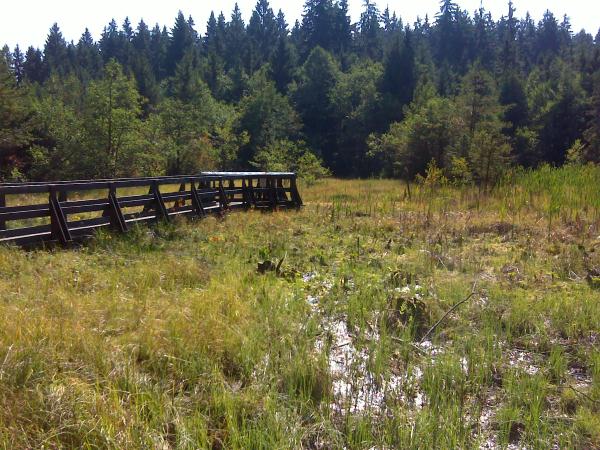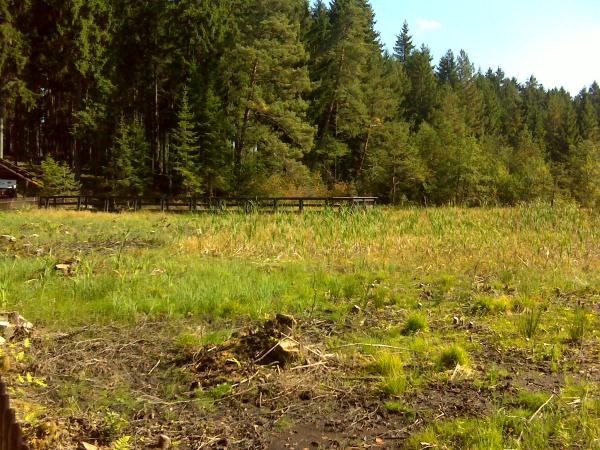Dieser Earthcache führt euch nach Bad Leonfelden.
Die Stadt ist als Kurort sehr bekannt, und den Ursprung des
Kurwesens vor Ort findet man im Moor hinter den Kurhäusern, das ich
euch hiermit gerne zeigen würde.

Entstehung eines Moores:
Moore entstanden nach der letzten Eiszeit aus abschmelzenden
Eismassen - sie sind "Kinder der Eiszeit", wie man auf einer
Infotafel vor Ort zu lesen bekommt. Sie wachsen an Standorten, an
denen ein Wasserüberschuss vorhanden ist (z.B. durch Niederschlag
oder durch Grundwasser). Anders als bei Sümpfen gibt es in Mooren
eine permanente Wassersättigung, eine stauende Gesteinsschicht im
Boden verhindert meist das Versickern des Wassers. Das wiederum
bedingt einen Sauerstoff- und Lichtmangel; die absterbenden
Pflanzenteile sinken ab und können im unteren Bereich nicht
vollständig zersetzt werden. Sie werden lediglich chemisch
umgewandelt und weitgehend konserviert. Eine Tatsache, die oftmals
auch dazu führt, dass in Mooren sensationelle archäolgische Funde
getätigt werden! Die pflanzlichen Reste lagern sich am Boden ab und
bilden eine Torfschicht, die langsam nach oben wächst. Man
unterscheidet, abhängig von der Art der Wasserversorgung und der
Geographie viele verschiedene Moortypen, wobei ich hierbei auf den
exzellenten Artikel bei Wikipedia verweisen möchte:
Torf:
Wie bereits erwähnt,
entsteht Torf durch absterbende, im Moor konservierte
Pflanzenreste, die chemisch verändert wurden. Genau betrachtet ist
Torf das erste Element auf dem Weg zur Bildung von Kohle. Daher ist
Torf, wird er getrocknet, brennbar. Torf besitzt eine grosse
wirtschaftliche Bedeutung, und wird an zahlreichen Stellen, nach
Trockenlegung der betroffenen Gebiete, im Tagbauverfahren abgebaut.
Leider werden dadurch wertvolle Ökosysteme für immer zerstört!!
Torf besitzt in etwa einen ähnlichen Brennwert wie Braunkohle, und
wird auch in eigenen Torfkraftwerken verheizt. Weitere
Einsatzmöglichkeiten für Torf finden sich in der Medizin und
Kosmetik, wie auch im nächsten Absatz beschrieben.
Das Moor in Bad Leonfelden, und seine
wirtschaftliche Nutzung:
In Bad Leonfelden macht man
sich die heilende und kosmetische Wirkung von Torf zunutze! Bereits
1860 entdeckte der ortsansässige Franz Kastner, dass sich seine
gichtgeplagten Füsse nach wiederholten Bädern im braunen Wasser
gesunder und kräftiger anfühlten. Er kaufte den damals noch als
wertlos angesehen Moorgrund, und errichtete unweit ein Kurhaus, das
Franzensbad. Der Badebetrieb erfreute sich grosser Beliebtheit, kam
aber nach Ausbruch des ersten Weltkriegs wieder zum erliegen. Bis
zur Errichtung des Kurhauses 1962 (das auch heute noch steht),
waren die Moorbecken vor Ort beliebte Badeplätze mit heilender
Wirkung für Kreislauf und Gelenke.
Der Cache:
Parke dein Auto
an den angegebenen Koordinaten, und folge dem "Erlebnisweg
Moorwald" bis zu den Koordinaten. Folge dabei immer dem lustigen,
hölzernen Eichhörnchen. Alle wichtigen Wegpunkt findest du unten
angeführt. Die gesamte Strecke beträgt etwa 2km, und ist zu Fuss
gut erreichbar, allerdings für Kinderwägen nicht geeignet.

Um diesen Earthcache loggen zu dürfen,
beantworte bitte folgende Fragen:
- an den Headerkoordinaten findest du einen Steg mitten in das
Moor hinein. Auf dem Steg sind zahlreiche Moorpflanzen aufgelistet
- nenne mir bitte 3 dieser Pflanzen.
- beim Wegpunkt "Info Board #1" findest du eine Warntafel, die
interessanten Aufschluss über die Schichtung des Moores gibt. Wie
dick ist die Moosschicht? Wie hoch steht das Moorwasser ohne festen
Grund?
- gehe zum Wegpunkt "Info Board #2". Suche ganz links auf der
Infotafel, welcher Klasse von Mooren dieses Moor zuzuordnen ist!
(schau genau!)
- Laut Infotafel rechts daneben, welche Pflanze zählt zu den
wichtigsten torfbildenden Pflanzen?
- Ebenfalls auf dieser Tafel, wie lange brauchte eine Torfschicht
von 2m um sich aufzubauen?
- OPTIONAL freue ich mich über alle Fotos von euch auf dem Steg
mit eurem GPS!
Schicke mir die Antworten per Mail, danach
darfst du deinen Fund gleich loggen, ohne auf die Antwort warten zu
müssen. Logs ohne die Antworten werden allerdings gelöscht.
This Earthcache takes you to Bad Leonfelden. This
small city in the "Mühlviertel" is famous for it's spa hotels,
which were founded due to the existence of a nearby bog. I want to
show you this interesting place, and I want to give you a short
introduction to this topic.

The origin of a bog:
Bogs
were formed after the retreat of the glaciers at the end of the
last ice age some 9,000 years ago. They exist at places, were there
is a permanent excess of water. This can be because of
precipitation or underground water. Certain layers of rocks prevent
this water from draining. Only little oxygen and light exists
within these areas, so that vegetation matter within cannot decay
and is mostly preserved. This is an interesting fact, which is also
the reason that archeologists often make sensational findings
within such bogs! Partially decayed vegetation matter accumulates
on the ground and forms a layer of peat. This peat slowly grows
over the years. Depending on different factors such as topography,
there are many different kinds of bogs. For more details, see the
interesting article on Wikipedia
Peat / Turf:
As mentioned
above, peat is formed from partially decayed vegetation matter,
which is preserved inside the bog. Peat is the earliest stage in
the formation of coal and very similar to brown coal. Upon drying,
peat can be used as fuel, so it became great economical importance.
Large areas are drained and it is harvested and dryied on an
industrial scale, so that certain ecosystems are completely
destroyed! But not only is it used for heating and electricity, but
also in agriculture and in balneology.
The bog at Bad Leonfelden and it's use in
balneology:
In Bad Leonfelden, people discovered the
medicinal and cosmetic use of peat already many years ago. In 1860,
Franz Kastner who suffered from the articular gout, discovered the
pleasent effects of bathing his feet in the brown water. He felt
better after several baths, so he decided to buy the land around
the bog, which was worthless at that time. Shortly afterwards, the
first spa, the so called "Franzensbad" was founded. The spa was
very popular among people, and it became more and more popular. The
bog and it's positive effects lead to the foundation of the first
spa hotel in 1962.
The cache:
Park your car at
the given coordinates, and follow the path called "Erlebnisweg
Moorwald". The path takes you to the header coordinates, just
follow the wooden squirrel. All additional waypoints are listed
below. The hole distance is about 2km and can be reached within
walking distance. I would not consider the area stroller
accessible.

To log your find, please answer the
following questions:
- at the header coordinates, you will find a wooden bridge
leading into the bog. At the end, the is a info board showing
several plants that grow in this area. Please mail me 3 of the
plants listed here.
- Waypoint "Info Board #1": you will find a warning sign, giving
information about the layers in the bog. How thick is the layer of
moss, and how deep is the bog?
- Waypoint "Info Board #2": look on the very left of the board,
and tell me, which kind of bog this is? ("Klasse von Mooren")
- According to the board right next to it, which plant is most
important for forming peat?
- Also very close to the board, you can find information about
how long it took to create 2m of peat.
- OPTIONALLY, I appreciate any pictures of you with your GPS on
the wooden bridge with the bog in the background!
Please send me the answers via E-Mail, and
thean, you may go ahead and log your find. You don't have to wait
for my logging permission, but logs without the answers will be
deleted!